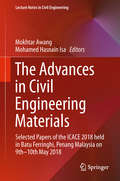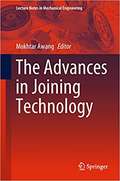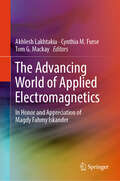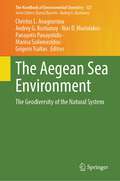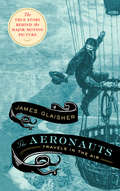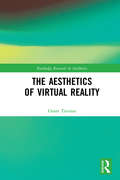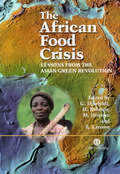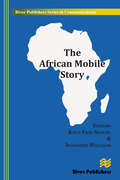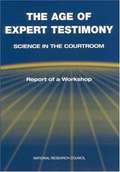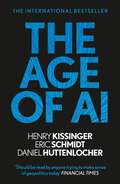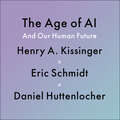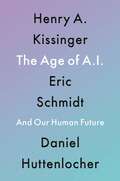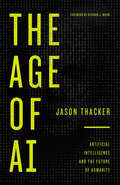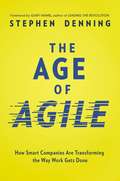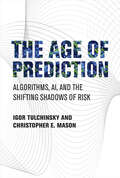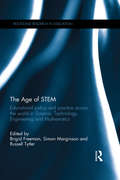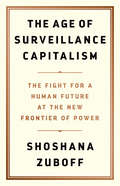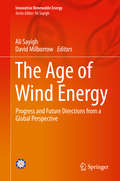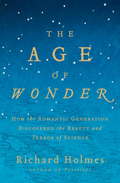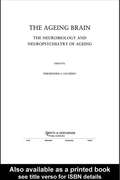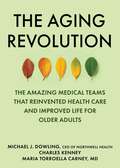- Table View
- List View
The Advances in Civil Engineering Materials: Selected Papers Of The Icace 2018 Held In Batu Ferringhi, Penang Malaysia On 9th -10th May 2018 (Lecture Notes in Civil Engineering #19)
by Mokhtar Awang Mohamed Hasnain IsaThis volume presents a compilation of research works in civil engineering. All manuscripts in this volume were presented during the 2nd International Conference on Architecture and Civil Engineering (ICACE 2018) which was held at Parkroyal Hotel, Penang, Malaysia on 09–10 May 2018. The editor(s) of the proceeding would like to express the utmost gratitude and thanks to all reviewers in the technical team for making this volume a success.
The Advances in Joining Technology (Lecture Notes In Mechanical Engineering)
by Mokhtar AwangPresents selected papers from the 3rd International Conference on Mechanical, Manufacturing and Process Plant Engineering (ICMMPE 2017) which was in Penang, Malaysia, 22nd–23rd November 2017.<P><P>
The Advancing World of Applied Electromagnetics: In Honor and Appreciation of Magdy Fahmy Iskander
by Akhlesh Lakhtakia Cynthia M. Furse Tom G. MackayThis book commemorates five decades of research by Professor Magdy F. Iskander (Life Fellow IEEE) on materials and devices for the radiation, propagation, scattering, and applications of electromagnetic waves, chiefly in the MHz-THz frequency range as well on electromagnetics education. This synopsis of electromagnetics, stemming from the life and times of just one person, is meant to inspire junior researchers and reinvigorate mid-level researchers in the electromagnetics community. The authors of this book are internationally known researchers, including 12 IEEE fellows, who highlight interesting research and new directions in theoretical, experimental, and applied electromagnetics.Provides a single-source reference to many of the most significant developments of the past 5 decades in theoretical, experimental, and applied electromagnetics;Offers readers in each sub-discipline discussed current research trends, the state of the art, the chief toolsneeded in that area, and the vision of a research leader for that area;Includes content of particular interest in Antennas and Propagation, as well as Microwave Theory and Techniques.
The Aegean Sea Environment: The Geodiversity of the Natural System (The Handbook of Environmental Chemistry #127)
by Andrey G. Kostianoy Christos L. Anagnostou Ilias D. Mariolakos Panayotis Panayotidis Marina Soilemezidou Grigoris TsaltasThis is the first of three Books that together provide an integrated picture of the Aegean Sea, presenting the natural components of the system (Book I and Book II) as well as the human presence in the extended area (Book III). The Aegean Sea, also called Aegean Archipelagos, is an open, complex, and diverse marine system situated between the Black Sea and the Eastern Mediterranean, with different compartments and interactions. This book provides an in-depth exploration of the Aegean Sea's natural systems, shedding light on its geodiversity, geological dynamics, air-land-sea interaction, hydrology, suspended matter and sediments. Divided into 4 parts, the book introduces the diversity, geological dynamics, and evolution of the natural system of the Aegean Sea (Parts 1 and 2), followed by a section devoted to the land-sea interaction in the Aegean coastal system where experts in the field explore freshwater and matter inputs into the Aegean coastal system, as well as the coastal morphodynamics and evolution of the Aegean Sea, its adjacent land areas, and islands. In Part 3, the book delves into the air-sea interaction over the Aegean Sea, presenting its intricate dynamics, including heat and freshwater fluxes, wind waves, tides, and atmospheric deposition. The book closes with a section focused on the hydrology, chemistry, and dynamics of water masses and the sea bottom, providing insights into suspended matter and fluxes, sediments, climate changes, and the intricate nutrient and carbon dynamics within the Aegean Sea ecosystem (Part 4). Given the breadth and depth of its coverage, this book serves as a valuable resource for researchers, scholars, and students interested in marine geology, oceanography, and environmental analysis, as well as policymakers and conservationists seeking a comprehensive understanding of the Aegean Sea's complex natural systems.
The Aeronauts: Travels in the Air
by James GlaisherThe True Story Behind the Major Motion Picture — and one of the greatest daredevil stories in the history of aviationIn 1862, ambitious scientist James Glaisher set out to do the impossible: ascend higher into the skies than ever before. A pioneer of weather forecasting and of photography, and a founding member of the Royal Meteorological Society, he wanted to take ground-breaking research measurements from different altitudes. On 5th September, along with experienced balloonist Henry Coxwell as his pilot, he lifted off in a hot air balloon for what would prove to be a death-defying and historic flight. Rising above the English countryside, they rose to the remarkable height of 37,000 feet (7 miles or 11km), almost killing both men, who experienced blurred vision, loss of motor function and, eventually, unconsciousness. It was a miracle they survived to tell the tale. Written in his own words, The Aeronauts chronicles Glaisher’s incredible flights and discoveries first hand, as well as his observations on those pioneers who came before and inspired him. His audaciously daring journey forms the story of the forthcoming major motion picture The Aeronauts. With an introduction by Professor Liz Bentley, Chief Executive at the Royal Meteorological Society
The Aesthetics of Virtual Reality (Routledge Research in Aesthetics)
by Grant TavinorThis is the first book to present an aesthetics of virtual reality media. It situates virtual reality media in terms of the philosophy of the arts, comparing them to more familiar media such as painting, film and photography. When philosophers have approached virtual reality, they have almost always done so through the lens of metaphysics, asking questions about the reality of virtual items and worlds, about the value of such things, and indeed, about how they may reshape our understanding of the "real" world. Grant Tavinor finds that approach to be fundamentally mistaken, and that to really account for virtual reality, we must focus on the medium and its uses, and not the hypothetical and speculative instances that are typically the focus of earlier works. He also argues that much of the cultural and metaphysical hype around virtual reality is undeserved. But this does not mean that virtual reality is illusory or uninteresting; on the contrary, it is significant for the altogether different reason that it overturns much of our understanding of how representational media can function and what we can use them to achieve. The Aesthetics of Virtual Reality will be of interest to scholars and advanced students working in aesthetics, philosophy of art, philosophy of technology, metaphysics, and game studies.
The African Food Crisis: Lessons from the Asian Green Revolution
by Goran Djurfeldt Magnus Jirstroml Rolf Larsson Hans HolmenThe goal of the research project resulting in this monograph was the systematic comparison between Asian agricultural development during the "Green Revolution" and the current agricultural situation in sub-Saharan Africa. The editors (from Sweden's U. of Lund and Link ping U.) include 14 papers that present and analyze macro- level data about national agricultural trends before, during, and after Structural Adjustment Programs and household-level survey data for comparison of countries. The analysis is geared towards investigating agro ecological, demographic, and technological obstacles to African agricultural development; the possible contributions of African smallholders to food security; the likely impact of market integration of small-scale integration on economic and ecological crisis; the inadequacy of export-oriented policies to meeting the demands of food security; and the relevance of the Asian model for Africa. Distributed in the US by Oxford U. Press. Annotation ©2005 Book News, Inc., Portland, OR (book news.com)
The African Mobile Story (River Publishers Series In Communications Ser.)
by Idongesit Williams Knud Erik SkoubyAfrica and especially Sub-Saharan Africa has during the past decade witnessed one of the fastest growing markets in mobile communication. This growth is recognized to have played a pivotal role in Africa’s socio-economic development. It has had a huge impact on residential living patterns; on business networks and models; and on government services and income sources. The mobile industry has contributed more to economic growth than in any other comparable region globally introducing innovative, broadly used applications. Technical topics discussed in the book include:• Mobile Development in Sub-Saharan Africa;• Telecom Liberalization in Africa;• Role of Mobile in Socio-economic Development;• Mobile Applications in specific sectors;• Security in African Mobile;• Role of Prepaid in Africa
The Age Of Expert Testimony: Science In The Courtroom
by Science Technology Law PanelThe federal courts are seeking ways to increase the ability of judges to deal with difficult issues of scientific expert testimony. The workshop explored the new environment judges, plaintiffs, defendants, and experts face in light of "Daubert" and "Kumho," when presenting and evaluating scientific, engineering, and medical evidence.
The Age of AI: And Our Human Future
by Eric Schmidt Henry A Kissinger Daniel HuttenlocherA Wall Street Journal Bestseller'IT SHOULD BE READ BY ANYONE TRYING TO MAKE SENSE OF GEOPOLITICS TODAY' FINANCIAL TIMESThree of our most accomplished and deep thinkers come together to explore Artificial Intelligence (AI) and the way it is transforming human society - and what it means for us all.An AI learned to win chess by making moves human grand masters had never conceived. Another AI discovered a new antibiotic by analysing molecular properties human scientists did not understand. Now, AI-powered jets are defeating experienced human pilots in simulated dogfights. AI is coming online in searching, streaming, medicine, education, and many other fields and, in so doing, transforming how humans are experiencing reality.In The Age of AI, three leading thinkers have come together to consider how AI will change our relationships with knowledge, politics, and the societies in which we live. The Age of AI is an essential roadmap to our present and our future, an era unlike any that has come before.
The Age of AI: And Our Human Future
by Eric Schmidt Henry A Kissinger Daniel HuttenlocherArtificial Intelligence is transforming human society fundamentally and profoundly. Not since the Enlightenment and the Age of Reason have we changed how we approach knowledge, politics, economics, even warfare. Three of our most accomplished and deep thinkers come together to explore Artificial Intelligence (AI) and the way it is transforming human society - and what it means for us all.An AI learned to win chess by making moves human grand masters had never conceived. Another AI discovered a new antibiotic by analysing molecular properties human scientists did not understand. Now, AI-powered jets are defeating experienced human pilots in simulated dogfights. AI is coming online in searching, streaming, medicine, education, and many other fields and, in so doing, transforming how humans are experiencing reality.In The Age of AI, three leading thinkers have come together to consider how AI will change our relationships with knowledge, politics, and the societies in which we live. The Age of AI is an essential roadmap to our present and our future, an era unlike any that has come before.(P) 2021 Hachette Audio
The Age of AI: And Our Human Future
by Eric Schmidt Henry A Kissinger Daniel HuttenlocherThree of the world&’s most accomplished and deep thinkers come together to explore Artificial Intelligence (AI) and the way it is transforming human society—and what this technology means for us all. An AI learned to win chess by making moves human grand masters had never conceived. Another AI discovered a new antibiotic by analyzing molecular properties human scientists did not understand. Now, AI-powered jets are defeating experienced human pilots in simulated dogfights. AI is coming online in searching, streaming, medicine, education, and many other fields and, in so doing, transforming how humans are experiencing reality.In The Age of AI, three leading thinkers have come together to consider how AI will change our relationships with knowledge, politics, and the societies in which we live. The Age of AI is an essential roadmap to our present and our future, an era unlike any that has come before.
The Age of AI: Artificial Intelligence and the Future of Humanity
by Jason ThackerAre robots going to take my job? How are smartphones affecting my kids? Do I need to worry about privacy when I get online or ask Siri for directions? Whatever questions you have about AI, The Age of AI gives you insights on how to navigate this brand-new world as you apply God's ageless truths to your life and future.We interact with artificial intelligence, or AI, nearly every moment of the day without knowing it. From our social media feeds to our smart thermostats and Alexa and Google Home, AI is everywhere--but how is it shaping our world?In The Age of AI, Jason Thacker, associate research fellow at the Ethics and Religious Liberty Commission, helps us navigate our digital age in this thoughtful exploration of the social, moral, and ethical challenges of our ongoing interactions with artificial intelligence.Applying God's Word to this new AI-empowered age, Thacker sheds light on:How Christian truth transforms the way we use AIHow AI affects us individually, in our relationships, and in our society at largeHow to navigate the digital age wiselyWith theological depth and a wide awareness of the current trends in AI, Jason is a steady guide who reminds us that while technology is changing the world, it can't shake the foundations of the Christian faith.Praise for The Age of AI:"The Age of AI informs us and assists us in envisioning a future that is filled with tools, influences, opportunities, and challenges relating to artificial intelligence. While many may fear the unknown future before us, Jason Thacker presents the imperative need to always lift up the constancy of the image of God and the dignity of all human life as presented in the Holy Scriptures, the Bible. I am thankful Jason's book can help churches, pastors, theologians, and Christian leaders in all vocations to wrestle through this current topic, always being committed to what this book states profoundly: God-given dignity isn't ours to assign or remove."--Dr. Ronnie Floyd, president and CEO, Southern Baptist Convention Executive Committee
The Age of Agile: How Smart Companies Are Transforming the Way Work Gets Done
by Stephen DenningAn unstoppable business revolution is under way, and it is Agile. Sparking dramatic improvements in quality, innovation, and speed-to-market, the Agile movement has helped companies learn to connect everyone and everything…all the time.With rapidly evolving consumer needs and technology that is being updated quicker than ever before, businesses are recognizing how essential it is to adapt quickly. The Agile movement enables a team, unit, or enterprise to nimbly acclimate and upgrade products and services to meet these constantly changing needs.Filled with examples from every sector, The Age of Agile helps you:Master the three laws of Agile Management (team, customer, network)Embrace the new mindsetOvercome constraintsEmploy meaningful metricsMake the entire organization AgileCompanies don&’t need to be born Agile. With the groundbreaking formulas laid out in The Age of Agile, even global giants can learn to act entrepreneurially. Your company&’s future may depend on it!
The Age of Clean Label Foods
by Charis M. GalanakisIn recent years, "clean label" has become a trendy term in the food industry, spurring innovations in food product development. While the concept of "clean label" is relatively new, without any legal definition, it has a high market appearance and industrial relevance. Consumer demands are leading food and beverage manufacturers toward removing synthetic additives (e.g., emulsifiers) and incorporating natural ingredients. Indeed, many big food companies have committed to eliminating artificial food additives from their products altogether. However, the substitution of chemical preservatives for natural ingredients without compromising food safety, convenience, and sensory quality is a challenge for food technologists.The Age of Clean Label Foods offers a guide to this approach with a thorough exploration of "clean label" ingredients in foods and the development of these food products. All aspects of clean label foods are covered in this essential reference, including recent developments in "clean label ingredients," technologies for producing or enhancing the functionality of ingredients, the interaction of ingredients with emerging food processing technologies, legislative frameworks, and consumer attitudes. Particular emphasis is given to trendy topics in the clean label industry, such as products with reduced-fat or reduced salt content, modified starches, natural emulsifiers, antioxidants, flavorings and antimicrobials, and fermented foods, as well as active and intelligent packaging for clean label foods. Through this text, the authors hope to promote a better understanding from which food technologists and food microbiologists can operate in the "clean-label" arena, taking into consideration all the key aspects of food quality, sensory characteristics, and food safety.
The Age of Living Machines: How Biology Will Build The Next Technology Revolution
by Susan HockfieldFrom the former president of MIT, the story of the next technology revolution, and how it will change our lives. A century ago, discoveries in physics came together with engineering to produce an array of astonishing new technologies: radios, telephones, televisions, aircraft, radar, nuclear power, computers, the Internet, and a host of still-evolving digital tools. These technologies so radically reshaped our world that we can no longer conceive of life without them. Today, the world’s population is projected to rise to well over 9.5 billion by 2050, and we are currently faced with the consequences of producing the energy that fuels, heats, and cools us. With temperatures and sea levels rising, and large portions of the globe plagued with drought, famine, and drug-resistant diseases, we need new technologies to tackle these problems. But we are on the cusp of a new convergence, argues world-renowned neuroscientist Susan Hockfield, with discoveries in biology coming together with engineering to produce another array of almost inconceivable technologies—next-generation products that have the potential to be every bit as paradigm shifting as the twentieth century’s digital wonders. The Age of Living Machines describes some of the most exciting new developments and the scientists and engineers who helped create them. Virus-built batteries. Protein-based water filters. Cancer-detecting nanoparticles. Mind-reading bionic limbs. Computer-engineered crops. Together they highlight the promise of the technology revolution of the twenty-first century to overcome some of the greatest humanitarian, medical, and environmental challenges of our time.
The Age of Prediction: Algorithms, AI, and the Shifting Shadows of Risk
by Igor Tulchinsky Christopher E. MasonThe power of the ever-increasing tools and algorithms for prediction and their paradoxical effects on risk.The Age of Prediction is about two powerful, and symbiotic, trends: the rapid development and use of artificial intelligence and big data to enhance prediction, as well as the often paradoxical effects of these better predictions on our understanding of risk and the ways we live. Beginning with dramatic advances in quantitative investing and precision medicine, this book explores how predictive technology is quietly reshaping our world in fundamental ways, from crime fighting and warfare to monitoring individual health and elections. As prediction grows more robust, it also alters the nature of the accompanying risk, setting up unintended and unexpected consequences. The Age of Prediction details how predictive certainties can bring about complacency or even an increase in risks—genomic analysis might lead to unhealthier lifestyles or a GPS might encourage less attentive driving. With greater predictability also comes a degree of mystery, and the authors ask how narrower risks might affect markets, insurance, or risk tolerance generally. Can we ever reduce risk to zero? Should we even try? This book lays an intriguing groundwork for answering these fundamental questions and maps out the latest tools and technologies that power these projections into the future, sometimes using novel, cross-disciplinary tools to map out cancer growth, people&’s medical risks, and stock dynamics.
The Age of STEM: Educational policy and practice across the world in Science, Technology, Engineering and Mathematics (Routledge Research in Education)
by Brigid Freeman, Simon Marginson and Russell TytlerAcross the world STEM (learning and work in Science, Technology, Engineering and Mathematics) has taken central importance in education and the economy in a way that few other disciplines have. STEM competence has become seen as key to higher productivity, technological adaptation and research-based innovation. No area of educational provision has a greater current importance than the STEM disciplines yet there is a surprising dearth of comprehensive and world-wide information about STEM policy, participation, programs and practice. The Age of STEM is a state of the art survey of the global trends and major country initiatives in STEM. It gives an international overview of issues such as: STEM strategy and coordination curricula, teaching and assessment women in STEM indigenous students research training STEM in the graduate labour markets STEM breadth and STEM depth The individual chapters give comparative international analysis as well as a global overview, particularly focusing on the growing number of policies and practices in mobilising and developing talent in the STEM fields. The book will be of particular interest to anyone involved in educational policy, those in education management and leaders in both schooling and tertiary education. It will have a wider resonance among practitioners in the STEM disciplines, particularly at university level, and for those interested in contemporary public policy.
The Age of Surveillance Capitalism: The Fight for a Human Future at the New Frontier of Power
by Shoshana ZuboffThe challenges to humanity posed by the digital future, the first detailed examination of the unprecedented form of power called "surveillance capitalism," and the quest by powerful corporations to predict and control our behavior. <P><P>Shoshana Zuboff's interdisciplinary breadth and depth enable her to come to grips with the social, political, business, and technological meaning of the changes taking place in our time. We are at a critical juncture in the confrontation between the vast power of giant high-tech companies and government, the hidden economic logic of surveillance capitalism, and the propaganda of machine supremacy that threaten to shape and control human life. <P><P>Will the brazen new methods of social engineering and behavior modification threaten individual autonomy and democratic rights and introduce extreme new forms of social inequality? Or will the promise of the digital age be one of individual empowerment and democratization? <P><P>The Age of Surveillance Capitalism is neither a hand-wringing narrative of danger and decline nor a digital fairy tale. Rather, it offers a deeply reasoned and evocative examination of the contests over the next chapter of capitalism that will decide the meaning of information civilization in the twenty-first century. The stark issue at hand is whether we will be the masters of information and machines or its slaves.
The Age of Wind Energy: Progress and Future Directions from a Global Perspective (Innovative Renewable Energy)
by Ali Sayigh David MilborrowThis unique volume on wind energy features contributions from the world’s leading research and development pioneers in the field of renewable energy. It discusses advances in offshore wind technology, grid-connected systems, grid stabilization and wind turbine design and highlights. Written from an international perspective, chapters focus on the status of wind energy in various regions and countries across the globe, outlining the positive impact its implementation has had on delaying the catastrophic effects of climate change.
The Age of Wonder: How the Romantic Generation Discovered the Beauty and Terror of Science
by Richard HolmesThe Age of Wonder is a colorful and utterly absorbing history of the men and women whose discoveries and inventions at the end of the eighteenth century gave birth to the Romantic Age of Science. When young Joseph Banks stepped onto a Tahitian beach in 1769, he hoped to discover Paradise. Inspired by the scientific ferment sweeping through Britain, the botanist had sailed with Captain Cook in search of new worlds. Other voyages of discovery—astronomical, chemical, poetical, philosophical—swiftly follow in Richard Holmes's thrilling evocation of the second scientific revolution. Through the lives of William Herschel and his sister Caroline, who forever changed the public conception of the solar system; of Humphry Davy, whose near-suicidal gas experiments revolutionized chemistry; and of the great Romantic writers, from Mary Shelley to Coleridge and Keats, who were inspired by the scientific breakthroughs of their day, Holmes brings to life the era in which we first realized both the awe-inspiring and the frightening possibilities of science—an era whose consequences are with us still.BONUS MATERIAL: This ebook edition includes an excerpt from Richard Holmes's Falling Upwards.
The Ageing Brain (Studies on Neuropsychology, Development, and Cognition)
by Perminder S. SachdevWhen confronted with a neurological or psychiatric disorder in an elderly individual, a clinician or researcher is likely to ask how the processes of ageing have influenced the aetiology and presentation of the disorder, and will impact on its efficient management. There are many urban myths about ageing, and some of these apply to the brain. The r
The Aging Revolution: The History of Geriatric Health Care and What Really Matters to Older Adults
by Charles Kenney Michael J. Dowling Maria Torroella CarneyA history of aging in the United States and an innovative blueprint for revolutionizing care for older adults from Northwell Health, New York&’s largest health care system. The New York Times described Dr. Robert Butler as &“the man who saw old age anew.&” In his 1975 book Why Survive: Being Old in America, Butler argued that for far too many people old age was &“a period of quiet despair . . . and muted rage&” and he set out to mitigate it. Nearly five decades since he penned his book, a devoted band of brilliant physicians and others in the healthcare field have realized at least a portion of Butler&’s dream: to recognize and alleviate suffering among the aging.The Aging Revolution is the story of Butler and his disciples: women and men who saw older distressed adults in hospitals and homes, and worse: being ignored by most of the medical establishment. These revolutionaries could not ignore the suffering, and they set out—individually and collectively—to create entirely new ways of caring for aging adults to ease their suffering and improve their quality and length of life. This revelatory book tells a story never-before told in its entirety, recounting the one of the most significant periods of improvement in American medical history. Readers will learn about pioneering individuals, concepts, and ideas that have improved the lives of millions, including: the women who placed the spotlight on delirium and falls—major issues for older adults; the campaign to build and spread Geriatric and Palliative Care; the small bands of doctors who worked the halls of Congress to create a new program that provides primary care along with home visits from healthcare professionals; and the New York-based foundation that has devoted its mission and millions exclusively to improving care and quality of life for aging adults. Today, as a result, chronic conditions that almost always accompany old age are far more manageable. Older people enjoy more options for work and professional development, for education, for leisure and travel, for sports and maintaining physical strength and mobility. For increasing numbers of Americans, life is healthier and richer in the experiences that matter most. Yet, aging in America can still be a challenge and, too often, particularly for the poor, a painful struggle. The range of mental and physical well-being has almost infinite variations: ninety-year-olds running marathons; sixty-five-year-olds incapacitated by stroke. While this book celebrates the incredible progress and strides made in this field, it also highlights areas that need improvement. The authors lay out specific steps that, if implemented, could ignite the aging revolution and diminish the total volume of older adults suffering in America.
The Agricultural Civilization of Ancient China
by Yaomin HeThis book provides a systematic account of the development of agriculture and agricultural civilization in ancient China. It mainly discusses the birth of traditional agriculture, the characteristics and advantages of traditional agricultural economy, traditional agricultural knowledge and technology system, flexible land relations and ownership structure, extensive irrigation system and water conservancy projects, complete policies and measures to emphasize agriculture, the three agricultural expansion processes, the value pursuit of revering agriculture, and the plight and decline of traditional agriculture.
